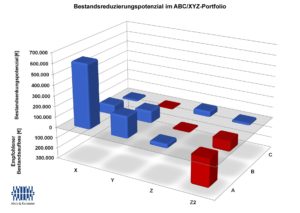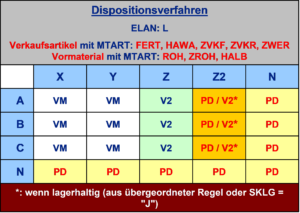How many items does your company produce? Several hundred? Several thousand? Multiply this figure by the amount of data that you or your employees have to keep an eye on every day: MRP master data, data for work preparation, forecasts, info records, order books, etc. This probably results in a figure of between 100,000 and one million. And these parameters are interlinked and influence each other. If you lose track of all this, you quickly run into delivery problems! The simplest solution to mastering this flood of information often seems to be to “play it safe”: Higher safety stocks, higher target figures, higher minimum lot sizes, plan for longer delivery times. However, the simplest solution is often not the best – and certainly not the most economical! In the following, we will show you eight steps to optimize your scheduling parameters so that you can maintain an overview, meet delivery deadlines on time and significantly improve warehouse performance.
Step 1: Classify items
Logistics means one thing above all: complex interrelationships between planning, scheduling and distribution of materials, know-how and manpower. If you first classify the articles, you reduce this complexity.
You create article classes in order to be able to decide on a class-specific basis which MRP parameter settings are logistically and economically optimal:
- the life cycle indicator,
- the ABC/XYZ/STU characteristics or
- the procurement indicator.
As a rule, further company-specific characteristics are added, which are used to take into account the respective restrictions in logistics and production (e.g. storage volume, multiple use, contractual agreements with suppliers and customers). Based on these item classifications, you now create a set of rules to define the parameters of your ERP system. This is necessary so that you can achieve the specified readiness for delivery per item with the lowest possible stock levels / stock flows.
Step 2: Optimize the supply chain with internal and external suppliers
First of all, check which suppliers / production areas / plants are worth changing the logistical parameters, such as delivery time, batch size, minimum quantity, etc., for. Include the feedback of your planners in the process. Together with the supplier, you then define the future processes and how you want to work together. Determine which boundary conditions influence the processes and how the MRP parameters should be set accordingly. You also define precise, comprehensible rules for these parameters.
Step 3: Create a class-related set of rules
You must now specify rules for the individual article classes: Is an article to be kept in stock or only procured when needed? Are pull mechanisms used or are push methods more suitable? What delivery readiness resp. What is your target availability? Should sales planning figures or statistical forecasts form the basis for planning? And how do you intend to deal with seasonality or fluctuating demand figures? You should formulate these and other questions clearly and derive specific measures or alternative courses of action to be examined from them.
Update 2021: current information on the topic – follow this link
Step 4: Check the effects of alternative rules and regulations using simulation
The effects achieved by the set of rules are crucial to the success of dispo parameter optimization. To avoid having to set this up with a lengthy, costly and dangerous “trial and error”, there is only one alternative: simulating the value stream and scheduling behavior of the procurement and production processes under different boundary conditions, with different scheduling parameter settings and using real demand structures and customer orders, e.g. from the last 12 months.With the help of a simulation system such as DISKOVER SCO, you can run through what effects the defined set of rules will have with regard to logistical criteria and the cost situation before you go live with the set of rules. Will the targeted delivery readiness be achieved? What does it cost to increase delivery readiness? Is there potential for reducing inventories and thus liquidity reserves? What additional work and what savings do the changes mean for production, logistics and suppliers? How do alternative concepts compare with each other?
Step 5: Translate the rules into setting values for the master data
Now it’s time to get specific: once you have developed clear business rules and checked their effectiveness, you need to translate them into structures that your ERP system can understand. Precisely define the characteristics of the individual material master data and MRP parameters. On the one hand, this means specifying precise settings, such as the scheduling method, batch size rule or planning strategy. Secondly, you will implement the rules you have developed in algorithms, e.g. for calculating the minimum lot size, the reorder points or the cover periods.
Step 6: Implement the set of rules as a sustainable solution
Due to the overwhelming volume of data, the logistics master data and scheduling parameters are hardly or only rudimentarily maintained in many companies. With the defined set of rules, you now have the option of mapping and automating data maintenance using software. The task of keeping master data up to date and checking it regularly is therefore performed by the computer. Your planners and schedulers can then focus more on monitoring and checking the quality of results and maintaining the rules and regulations. This drastically reduces the effort required for data maintenance – with higher data quality and better planning and scheduling results.
Step 7: Training and coaching after the go-live
Even if this point is almost at the end, it is the decisive factor in implementation. Only trained and convinced warehouse and scheduling staff will let go of old procedures and use the new set of rules. Therefore, train your team thoroughly. If necessary, also consider “method training”. Your employees will learn scheduling principles that have not yet been applied but are now being used. After the training phase and the operational changeover to the new set of rules, your planners and dispatchers should have contact persons who can answer questions or solve problems at short notice and, if necessary, help to rectify errors. This coaching task should be taken on by people who have been involved in the conceptual development of the regulations, e.g. the consultants involved.
Step 8: Install regular controlling of the parameter set
In order to achieve a sustainable solution, you must regularly monitor and check the dispo parameter rules. On the one hand, this serves to check the effectiveness of the new set of rules: if necessary, you still need to make fine adjustments here. On the other hand, it serves to recognize deviations from the rules: There may be reasons why an item cannot be planned according to the standard. You must track down such articles and coordinate them with the dispatcher. There may be a gap in the regulations that you want to close quickly or there may be ambiguities that need to be resolved. It is best to organize the ongoing maintenance and monitoring of the rules and regulations together with your employees and, ideally, seek external advice. This will prevent you from being too hesitant when it comes to optimization or running into the “blind spot” of a well-established operation – which could mean you are wasting valuable potential.go through these eight steps consistently and optimize your scheduling parameters – but please don’t do it based on feeling and the sound of waves, but on hard business calculations. This not only helps your dispatchers and planners, but also the entire company to work more efficiently and effectively. Scheduling is the heart of the company and only effective scheduling leads to an effective value chain.

